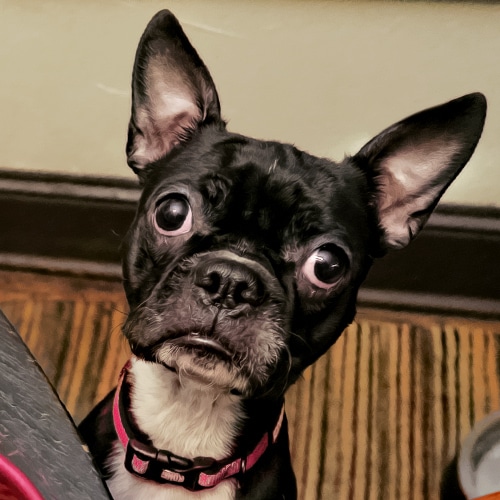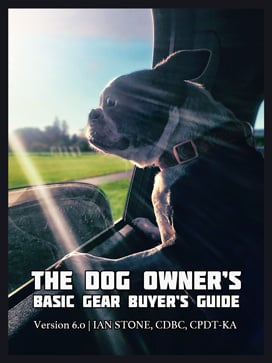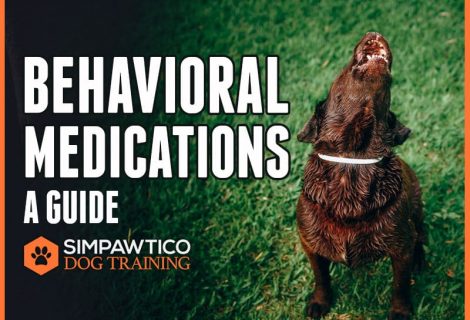Bringing Home A New Dog – 5 Tips From Olive’s First Week
Bringing home a new dog creates many challenges, and a dog’s first week at home can set the tone that’ll make or break you. Whether you’re getting a new puppy or you’re adopting an older dog from a shelter or a rescue, that first week is a crucial period that sets the tone, in some cases, for the rest of their lives. As some of you know, we just adopted a new dog ourselves, and I thought documenting how we approach this process would be helpful to all of you.
THIS IS OLIVE!
 She’s a two-year-old old Boston Terrier. She was first picked up as a stray by animal control in the next city over. When her original owner was located, he said, “Whatever, I don’t have time for her anyways,” and signed her over to the city. Soon she was put up for adoption. My wife saw her on the shelter’s Facebook page, and we went down to take a look. Well, that was pretty much it. We took her home that day.
She’s a two-year-old old Boston Terrier. She was first picked up as a stray by animal control in the next city over. When her original owner was located, he said, “Whatever, I don’t have time for her anyways,” and signed her over to the city. Soon she was put up for adoption. My wife saw her on the shelter’s Facebook page, and we went down to take a look. Well, that was pretty much it. We took her home that day.
Olive was underweight and malnourished. She’d had puppies at some point. She was not spayed, but thanks to the shelter, she was up to date on her shots. We changed her name to Olive, so we knew she wouldn’t know her new name immediately, which is just as well because she didn’t seem to respond to her original name either. In fact, she didn’t seem to know much of anything, which tells me that she probably had very little support or training at home.
BEGINNING THE PROCESS
One of the first things we did with Olive was to put our primary focus on the routines and procedures in our home. Management in that first week is the most important thing you can do for any new dog. Most people want to start by teaching their new dog behaviors, tricks or doing fun things together. Please believe me: that is a waste of valuable time right now. Focusing on structure and procedures and practicing those until they become routines is essential for a new dog’s long-term success. Otherwise, bad behavior usually sends them back into the shelter system, or puppies return to the breeder, and it’s not their fault.
If a dog misbehaves in your home, it’s your fault! You cannot reasonably expect a dog to enter your home and magically know your expectations. And if you plan to punish them until they figure it out, that is the worst thing you could do. The home must be a safe and protected environment where a dog can come to learn without fear. And I’m telling you right now that the number one problem with dog behavior is not discipline; it is management; it is the lack of procedures and routines.
Prioritize
It stands to reason that before you try to teach them what you want, YOU had better know what you want! So, to start, you need to sit down with the family and think about all the procedures and routines you’ll need to make the house run smoothly with the dog and then devise a management plan to make it happen. The golden rules here are:
- The more structure there is, the more successful your dog will be.
- And the more precise the instructions, the higher the achievement rate will be.
With Olive, we picked 5 big goals to focus on in her first week:
- Potty
- Food
- Nighttime
- Home Alone
- Around the House
Let’s take a look at each of these.
GOING POTTY
Where and how do we go potty? Of course, potty training is paramount for a new dog of any age. But, unfortunately, it’s one of the most common problems people complain about.
Imagine if you walked into a building in a foreign country, and NONE of the bathrooms were marked. You wouldn’t know where to go, you wouldn’t be able to ask anyone where to go, and the longer you had to wait, the more desperate you’d get. Then, finally, you might even get to where you did some radical things to relieve yourself.
We must communicate to the dog where they go potty, and we have to engineer the space and their life so that it’s almost impossible to mess it up. Then, we reinforce the heck out of it.
Set Up a Routine
The best way to approach this with a newly adopted dog is similar to how we do it with a puppy: take them out at regular intervals to the same place every time. Take them out when they get up in the morning, when you come home, and within 15 to 20 minutes after meal times. Praise and reward lavishly when they do their business outside. Do your best not to let there be mistakes, as this will compromise your training. But, if there are mistakes, realize they’re still learning and don’t get too worked up. Clean it up, and move on.
For Olive, we made a concerted effort to make the first week as error-free as possible. That meant that Olive was under constant supervision. She was not allowed to go out of sight, and rooms were closed when we weren’t with her. She was also confined when we were not at home.
We took almost the same approach we would to a new puppy. We took her out often during the day, always to the same spot, and waited with her. Of course, being two years old, the job was admittedly easier than it would’ve been with a puppy. But that doesn’t mean that we didn’t have to stay vigilant and try to read her signs. We took her out first thing in the morning, as soon as we got home from anywhere, soon after breakfast and dinner, and every three to four hours whether it seemed she needed to or not.
Our other dogs helped in this process too. Even though they were already potty pros, we praised them in front of her when they went, and you could see her paying attention. Soon this meant when we called everybody for potty time; it didn’t take long until she was running right out with them and even asking to go out in the morning if she was the first one up.
FOOD
Where, when, and how do we get meals? As you’ve no doubt heard me say before, I am a massive advocate of routine, timed feedings. Free feeding is shooting yourself in the foot in many ways, especially with a new dog. So for Olive—just as with the other dogs—she was fed:
- twice a day,
- at approximately the same times,
- in the same place, the same order, and the same way
- every single time.
Because of the consistency of the routine, it only took a couple of days for her to figure it out. She’d dive into Dexter’s food the first few times and try to get there. After that, she quickly learned to hang out and wait for her bowl with some gentle but consistent feedback and positive reinforcement. She knew it was coming, she knew where to wait for it, and there was no need to get silly.
We don’t expect sit-stays or anything like that in our home. We expect it to be mannerly and don’t tolerate stupid hijinks, but it’s pretty laid-back and relaxed overall. However, we fill the food bowls on the table and place them on the floor in the same order as I said, every morning and every night. So food bowls always go down: Dexter, Darwin, Olive. ALWAYS.
Those of you who enjoy a more rigid routine with more steps and higher expectations, great! Knock yourselves out. And honestly, some dogs out there NEED that level of detail in their routines due to their high energy and drive. These are dogs that will need sit-stays, for example, before they can eat, and so on. However, you do it; it needs to be outlined, it needs to be shared with everyone in the house, and it needs to be executed that way every time. Routines are the backbone of good behavior!
NIGHTTIME
Does your dog sleep in the crate or on a doggie bed? Where is that located? Do they sleep in your room? Do they sleep on your bed? With one of your kids? What time is bedtime? And if they’re on the bed, what are the rules? Do they move if you ask them to? They should.
By asking these questions, we would know, for example, that if your dog is going to sleep in a crate, then you know you’d better make sure that crate training is squared away and devote some time to that. Don’t just stuff the dog in there and hope for the best. Be proactive to make every part of the process as successful as possible.
In our home, the dogs sleep on the bed with us. This went pretty smoothly, despite a little problem chewing on the blankets I’ll address in another post. However, if Olive had been a new puppy, I would have opted to have her sleep in a crate for the first few months so we could work on other essential puppy skills. Puppies always need way more structure in their lives than an adult dog does.
PUPPY PRO TIP
Most people screw up their puppy because they do the structuring backward: they start with very little structure, then they run into potty training and behavior problems, so then they try to introduce more structure to patch issues gradually. This is totally ass-backward. Puppies should start with a hyper-structured life and graduate to increasing autonomy as they get older and better.
HOME ALONE
Where is your dog kept while you’re gone? In a crate, in a pen, or a specific room? Do they have free range of the house? Do they have good things to do to keep them busy? Have you trained them to occupy themselves? Again, this goes along with what I just said a second ago.
In our case, all the dogs are crated in the basement while we’re away. Dexter and Darwin cruise right in without any trouble. Olive needed a little coaxing but seemed to accept it.
This was also helpful in making sure her potty training was on target. If we’d left her alone loose, the probability of a mistake would have been very high.
Honestly, her biggest hurdle was the basement stairs. She was initially very timid about them. But now, she’s comfortable enough to fly down them into the basement with the other dogs.
Social learning
On another side note, you should be noticing a pattern here. Any dogs you already have can cut your training time down drastically; this is called social learning. Dexter and Darwin have been instrumental in showing Olive the ropes. She sees them doing things, getting rewarded and praised, and offers to try it herself. When that also results in rewards and praise, she’s hooked!
When you bring your new dog home, if you already have a dog or dogs, it’s tremendously advantageous to ensure they’re already on board with your management plan. If they know the expectations of the routines and procedures, they’ll blaze a trail for the new dog to follow.
You can find more helpful tips about leaving your dog home alone in this blog post at Porch.
AROUND THE HOUSE
How do we enter and exit the house? Is the dog allowed on the furniture? Are there particular pieces of furniture that the dog is allowed on? Do they have a bed in certain rooms? Where are toys kept? What toys are free-access, and what toys are restricted access? How do we interact with different family members, including other pets? What provisions have you made to help your other pets adjust? Other dogs, cats, rabbits and guinea pigs, birds, etc… all need guidance and support to adjust.
Even in the Car!
This extends to outside the home, too. For example, how does the dog enter and exit the property? How does the dog enter and exit the car? Where does the dog ride in the car? Are they in a crate or seat-belted with a harness? What parts of the yard are they allowed in? How should they behave while the kids are outside playing? What are the boundaries of their property?
Choose Exits and Entrances Carefully
One example my wife and I are ironclad on is which door we go in and out of. We have a front door and a back door. Dogs are very location specific and do not generalize well, so a routine can program them to look at things a certain way. My dogs have never, ever, even one time entered or exited through the front door. I don’t want them to consider it a viable exit because there’s a road just 10 yards away. Consequently, Dexter and Darwin won’t go through it. I can come and go, and I’m sure under the right circumstances they’d go through it if I asked, but that five seconds or so of hesitation as they contemplate and then check in with me could be the instant I need to interrupt with a life-saving command.
In this vein, Olive will learn this too. As her original owner mentioned that she had a habit of getting out, I want to teach her to forget about that front door.
WHAT ABOUT BEHAVIORS?
You may notice that we didn’t really focus on individual behaviors like Sit or Come or Stay. These are still important, but I think focusing FIRST on the management is much more critical in the first week. Focusing on management also helps you identify the most important behaviors to teach first. Many people pick what they THINK are the first ones they should teach. They spend tons of time on Sit, Down, Stay, and Come because every dog should know those, and then they also waste much of that first time doing fun tricks like Shake and Rollover, which, while entertaining, are both completely useless.
Don’t waste your time.
Do you know how many shelter dogs can shake? All of them! Maybe if they had been adequately taught how to coexist in a human household, however, they’d still be there. By emphasizing the management, you can swiftly identify the weak points and get those down FIRST.
For example, I mentioned that some people expect a sit-stay before the food goes down. For a high-energy and high-drive dog, that’s great. Then teaching Sit and a Stay in the spot where the food goes down is one of the first things you’d teach. That’s more impactful than just doing random Sits and Stays in the living room. Put it to work immediately so you can enjoy a functioning and happy household as soon as possible.
As I mentioned in Olive’s case, working on getting comfortable with the stairs was something we needed to square away soon. This was more important to our management plan than a Stay or even a Sit for right now. Knowing our end goals allowed us to prioritize the needed training pieces and use time efficiently.
Reasonable expectations
Please understand that you will not get perfection in the first week. But you will be laying a solid foundation to grow on. And as you move on to teaching more and more things to your dog, you’ll have established a practical framework for them to make sense of those things.
Sits and Stays and stuff like that will take on a greater meaning because they’re being used in a real-world context. Don’t teach Sit and Down and Stay so you can use them randomly to try and control the dog. Instead, use them as steps to complete in sensible routines that keep your home running smoothly.
GOOD LUCK IN BRINGING HOME A NEW DOG!
Bringing home a new dog can be exciting, but preparing your home and yourself for your furry friend’s arrival is essential. Following these tips can help make the transition smooth for you and your pup.
Have you brought home a new dog recently? Tell me about your experience in the comments below!
In the meantime, keep learning, keep practicing, and we’ll see you in the next post!










I find your videos vey interesting and I was looking forward to implementing your advice when we brought home our rescue dog of 9 months. She is a creole and was with the foster for 5 months. Unfortunately she has a lot of anxiety with people and environment. She lived in the countryside with her foster and is now in the city with us. Its her first time with no other animals and with two people instead of one. We bring her down 3 times a day for the toilet (She will go out of the crate to the door for me but not my boyfriend.) but it is scary for her with the elevator, doors & meeting other people in the halls. We have her over one week. She is still not approaching us and we haven’t been able to take her for a walk. Just around the apartment complex grounds. I’m trying to give her food by hand as a means to engage. She is not interested in treats or toys. She’s not aggressive just nervous. If you have any advice I would appreciate it.
Hi. I adopted a 9 yr old female pit bull who I knew to be very easy-going. Unfortunately, the first 24 hours, I also had a house full of grandkids and 3 other dogs, and yes, Layla acted out. Along with another set of instructions on the first 2 weeks decompression, your instructions about bringing Olive home were a life-saver, and calmed the situation down and gave me great focus to work with her. Now it is 3 1/2 weeks later, and the rhythm and structure has made for a great atmosphere, including with the 12 yr old chihuahua Uno! I look much more carefully and calmly about what I am expecting, and am setting her up for success by repetition and the same few commands – Settle (at the front door when she is excited), Out (if she is in the kitchen) Get your toy ( to give her something to do) and Go Swim (when I take her to the stream, which she loves). Thank you for your great website. I have shared it with many other adopters.
That’s so gratifying to hear, thank you for sharing! Great job implementing everything, and keep up your fantastic work!
Hello! Thank you for the useful post! The first time I brought my dog to the house, she was 3 months old. Through proper and consistent training, she developed a habit on where to potty, sleep and eat. However, it was easy to train her because she was a puppy. Now that I’m planning to move to another house, it’ll be a new environment, and she’s 4 years old. I wonder how stubborn they can get and how harder they are to train when they are older?
It’s more challenging when they’re older, for sure. But, if you go in knowing it’s going to be a slower process, you can approach with more sensitivity and patience. At least that’s my feeling. Plus, some things won’t need to be completely retaught, just adjusted for the new space. Also depends on the individual (just like us). Some are game for the adventure and take to it quickly, and some resist change and react. You won’t know until you’re in it!